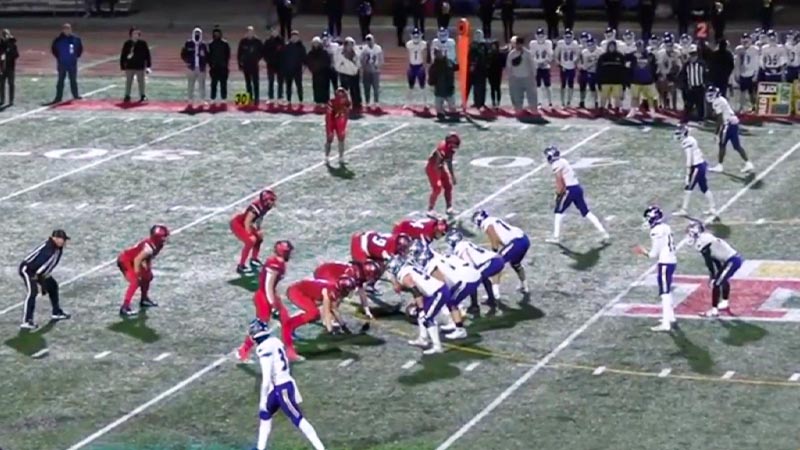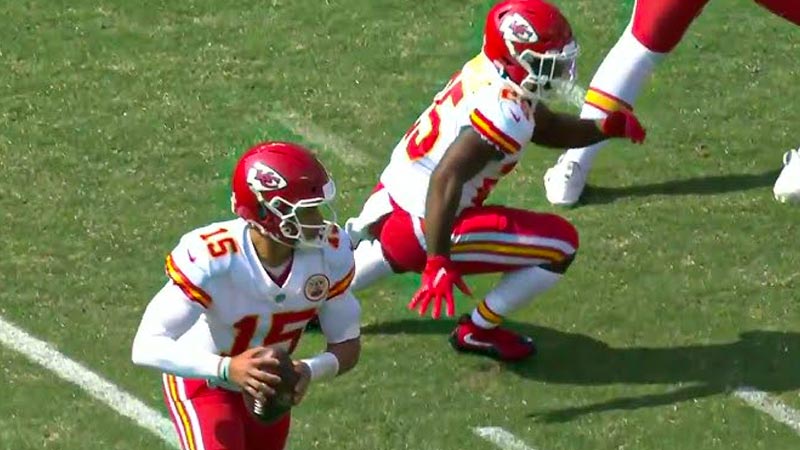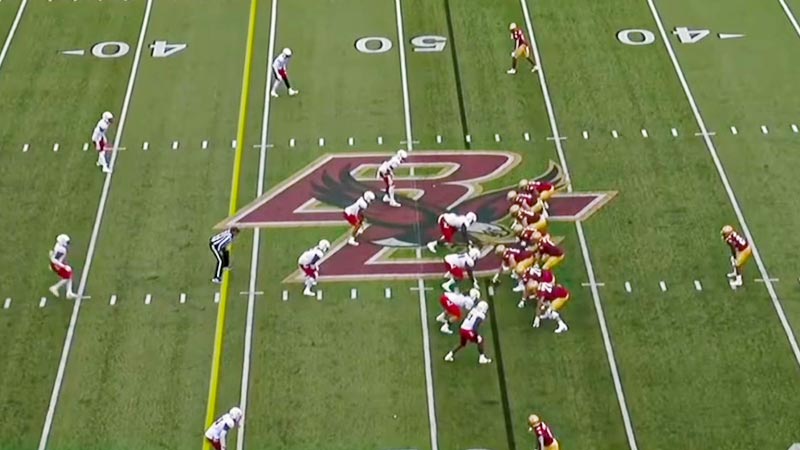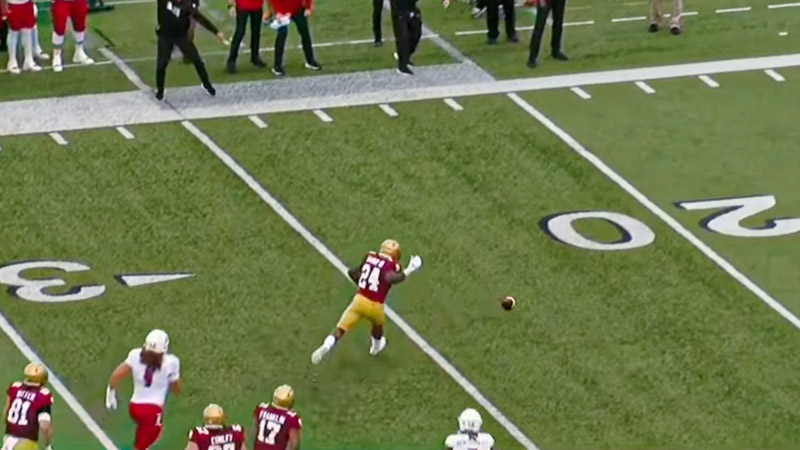In the world of American football, precision, strategy, and adherence to rules are paramount. One of the fascinating and often strategic aspects of the game is the backward pass, also known as a lateral.
This maneuver involves passing the ball to a teammate positioned behind the passer, and while it may seem straightforward, its execution is subject to a set of crucial rules that impact gameplay.
In this guide, we delve into Football Backward Pass Rules, answering some of the most common questions and providing insights into how this element of the game is implemented. So, stay focused.
What Are Football Backward Pass?
In American football, a backward pass, also known as a lateral or lateral pass, occurs when a player throws the ball to a teammate positioned behind them on the field.
Unlike a forward pass, which can only be thrown by a player positioned behind the line of scrimmage, a backward pass can be made by any player at any point on the field. This play is often used strategically to advance the ball down the field, confuse the defense, or set up trick plays.
However, it comes with a higher risk since if the ball is dropped or mishandled, it’s considered a fumble, and either team can recover possession. Backward passes are a fundamental aspect of American football’s tactical gameplay, requiring precision and teamwork to execute effectively.
Rules of Football Backward Pass

The rules regarding backward passes (laterals) in American football are crucial for understanding their execution and consequences:
Direction
A backward pass is thrown toward a teammate positioned behind the passer. The direction of the pass must be parallel to or behind the line of scrimmage.
Position of Passer
Unlike a forward pass, which can only be thrown by a player who has not crossed the line of scrimmage, any player can throw a backward pass, regardless of their position on the field.
Fumble Potential
If the backward pass is not caught by the intended teammate and the ball touches the ground, it is considered a live ball and can be recovered by either team. If the defense recovers the ball, they gain possession at the spot where the ball was recovered.
Advance
The player who catches a backward pass can attempt to advance the ball, either by running with it or by throwing another legal backward pass. There is no limit to the number of backward passes in a play, as long as they remain behind the line of scrimmage.
Scoring
If a backward pass is caught by an offensive player behind the line of scrimmage and then thrown forward for a touchdown, it is considered a legal play. However, such plays are rare due to the increased risk of fumbles.
Out of Bounds
If a backward pass goes out of bounds, the ball is considered out of play and the down is considered dead at the spot where the ball crossed the sideline.
Intentional Grounding
A backward pass that goes out of bounds without being touched by anyone (teammate or opponent) can result in an intentional grounding penalty if the passer is under pressure and throws the ball to avoid a sack.
Purposes of Football Backward Pass

The backward pass, also known as a lateral, serves several strategic purposes in American football:
Yardage Gain
When executed successfully, a backward pass can be a tool for gaining yardage. By quickly transferring the ball to a teammate in a better position to advance, teams can exploit openings in the defense and potentially make significant gains.
Trick Plays
Backward passes can be used as a part of trick plays or unexpected strategies to catch the defense off-guard. This could involve a lateral to a non-quarterback player who then throws a pass downfield, adding an element of surprise.
Screen Passes
Screenplays involve a short backward pass to a receiver positioned behind the line of scrimmage. The offensive line creates a protective wall, allowing the receiver to catch the pass and potentially gain yardage while having blockers in front.
Reverses and End-around
These plays often involve wide receivers or running backs receiving backward passes while moving laterally or even diagonally across the field. This misdirection can confuse the defense and create opportunities for big gains.
Emergency Situations
When a quarterback is about to be tackled and unable to make a forward pass, they may opt for a backward pass to avoid a sack or grounding penalty. This can minimize losses in yardage.
Extended Plays
In broken plays or when the intended target of a forward pass is covered, a quarterback might resort to a backward pass to extend the play, giving receivers more time to get open.
Ball Possession
Backward passes can help maintain ball possession and control. If a team is in danger of losing the ball (e.g., due to a fumble or pressure from the defense), a backward pass can redirect the ball to a teammate rather than risk a turnover.
Clock Management
In situations where a team wants to run out of the clock, executing backward passes can consume additional time as players move laterally or backward before being tackled.
Penalties to Violate Football Backward Pass Rules

Violating the rules regarding backward passes (laterals) in American football can result in penalties for the offending team. Some penalties associated with backward pass rules include:
Illegal Forward Pass
If a backward pass is thrown forward beyond the line of scrimmage, it is considered an illegal forward pass. This results in a penalty for an illegal forward pass, which typically includes a loss of down and a loss of yards from the spot of the pass.
Fumble
If a backward pass is not caught by the intended teammate and the ball touches the ground, it’s considered a fumble. The opposing team can recover the fumble and gain possession at the spot where the ball was recovered.
Intentional Grounding
If a backward pass goes out of bounds without being touched by anyone and the passer is under pressure, it can result in an intentional grounding penalty. This penalty includes a loss of down and a loss of yards from the spot where the ball was thrown.
Illegal Touch
If a player who is not an eligible receiver (e.g., an offensive lineman) catches a backward pass, it’s considered an illegal touch. This results in a penalty, and the down is replayed from the original line of scrimmage.
Unsportsmanlike Conduct
If a player intentionally throws a backward pass out of bounds to waste time or create confusion, it might be considered unsportsmanlike conduct. This could result in a penalty and potential ejection from the game, depending on the severity of the action.
Ineligible Receiver Downfield
If an ineligible receiver (e.g., an offensive lineman) moves downfield before a backward pass is thrown, it can result in an ineligible receiver downfield penalty. This penalty typically includes a loss of yards and the down is replayed.
Illegal Motion
If a player goes in motion toward the line of scrimmage before a backward pass, it could be considered an illegal motion. This results in a penalty, and the down is replayed with a loss of yards.
Unnecessary Roughness
If a backward pass is thrown after the play is dead and the opposing defense unnecessarily hits a player, it could result in an unnecessary roughness penalty, which adds yards to the offensive team’s progress.
These penalties emphasize the importance of proper execution of backward passes within the rules of the game. Coaches and players need to understand these rules to avoid costly penalties that can negatively impact their team’s performance.
Implementation of Football Backward Pass Rules
The implementation of football backward pass rules in American football is overseen by the game officials on the field, who ensure that the rules are followed correctly. Here’s how the implementation typically works:
On-Field Officials
American football games are officiated by a crew of referees and officials. Among them, the head referee and the line judge are primarily responsible for monitoring plays involving backward passes.
Positioning
Officials position themselves strategically on the field to have clear views of the action. The line judge is particularly responsible for monitoring the line of scrimmage and determining if a pass is thrown forward or backward.
Spotting the Ball
If a backward pass occurs, officials immediately identify the spot where the pass was thrown and the spot where it was caught. This helps them determine whether the pass was legal or if penalties should be applied.
Integrity of Lateral
Officials carefully assess the trajectory of the pass to ensure it meets the criteria of being thrown parallel to or behind the line of scrimmage. Any forward trajectory can result in a penalty for an illegal forward pass.
Fumble and Recovery
If a backward pass is not caught and the ball touches the ground, officials determine whether it’s a fumble. If a fumble occurs, officials also assess which team recovers possession of the ball and at what spot.
Penalties
If a violation of the backward pass rules occurs, officials throw penalty flags to indicate the infraction. They announce the penalty, its yardage implications, and the team affected. Penalties may result in changes in possession, loss of down, or loss of yardage.
Instant Replay
In some cases, coaches can challenge the ruling on the field using the instant replay system. This includes reviewing whether a backward pass was indeed legal, whether a fumble occurred, or if a player stepped out of bounds during a backward pass play.
Communication
Officials communicate their decisions to both teams and the spectators. They signal the direction of possession, announce penalties, and explain the reasons for their rulings.
Enforcement
Officials work with both teams to enforce penalties correctly, marking off the yardage and adjusting the line of scrimmage as necessary.
Video Review
In some leagues, a centralized video review system may be used to assist officials in making correct calls, especially on complex backward pass plays.
The implementation of backward pass rules requires a deep understanding of the game’s intricacies and rules by the officiating crew. Their decisions play a crucial role in maintaining the integrity of the game and ensuring fair play.
FAQs
What is a backward pass in football, and how is it different from a forward pass?
A backward pass, also called a lateral, occurs when a player throws the ball to a teammate positioned behind them on the field. This differs from a forward pass, which must be thrown parallel to or ahead of the line of scrimmage.
Unlike forward passes, which are restricted to specific players and positions, backward passes can be attempted by any player at any location on the field.
What are the strategic purposes of using backward passes?
Backward passes serve various strategic purposes. They can be used to gain yardage, set up trick plays, execute screen passes, mislead the defense with reverses and end-arounds, and extend broken plays.
Additionally, backward passes can aid in maintaining ball possession and control, making them an integral part of a team’s offensive toolkit.
What are the potential penalties for violating backward pass rules?
Violating backward pass rules can result in penalties such as illegal forward passes, fumbles, intentional grounding, illegal touches, ineligible receiver downfield, and unsportsmanlike conduct.
These penalties can lead to loss of yards, loss of down, or changes in possession, underlining the importance of proper execution of backward passes.
How do officials determine the legality of a backward pass during a game?
On-field officials, including the head referee and line judge, play a critical role in implementing backward pass rules.
They assess the trajectory of the pass, identify the spot of the throw and catch, and determine if the pass is legal or not. Video review systems might be employed in certain leagues to assist officials in making accurate calls.
Can a backward pass lead to scoring a touchdown?
Yes, a backward pass can contribute to scoring a touchdown. If a backward pass is caught by an offensive player behind the line of scrimmage and subsequently thrown forward to a teammate who scores a touchdown, the play is considered legal.
However, this kind of play is relatively rare due to the higher risk of fumbles.
Wrapping Up
The intricacies of football backward pass rules add depth to one’s appreciation of the game’s strategic nature.
From gaining yardage to trick plays and misdirection, backward passes bring an element of surprise and calculated risk to the field.
While penalties can result from improper execution, teams that master the art of the backward pass gain a valuable tool in their offensive playbook, enabling them to outmaneuver opposing defenses and secure their path to victory. Thank you for the warm support.







